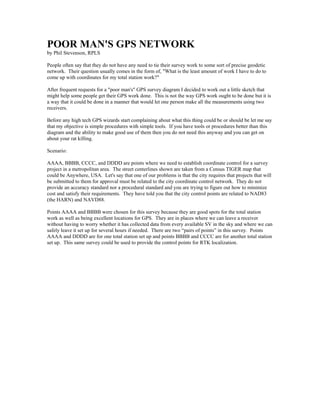
Poor mans GPS by Phil Stevenson
- 1. POOR MAN'S GPS NETWORK by Phil Stevenson, RPLS People often say that they do not have any need to tie their survey work to some sort of precise geodetic network. Their question usually comes in the form of, "What is the least amount of work I have to do to come up with coordinates for my total station work?" After frequent requests for a "poor man's" GPS survey diagram I decided to work out a little sketch that might help some people get their GPS work done. This is not the way GPS work ought to be done but it is a way that it could be done in a manner that would let one person make all the measurements using two receivers. Before any high tech GPS wizards start complaining about what this thing could be or should be let me say that my objective is simple procedures with simple tools. If you have tools or procedures better than this diagram and the ability to make good use of them then you do not need this anyway and you can get on about your rat killing. Scenario: AAAA, BBBB, CCCC, and DDDD are points where we need to establish coordinate control for a survey project in a metropolitan area. The street centerlines shown are taken from a Census TIGER map that could be Anywhere, USA. Let's say that one of our problems is that the city requires that projects that will be submitted to them for approval must be related to the city coordinate control network. They do not provide an accuracy standard nor a procedural standard and you are trying to figure out how to minimize cost and satisfy their requirements. They have told you that the city control points are related to NAD83 (the HARN) and NAVD88. Points AAAA and BBBB were chosen for this survey because they are good spots for the total station work as well as being excellent locations for GPS. They are in places where we can leave a receiver without having to worry whether it has collected data from every available SV in the sky and where we can safely leave it set up for several hours if needed. There are two “pairs of points” in this survey. Points AAAA and DDDD are for one total station set up and points BBBB and CCCC are for another total station set up. This same survey could be used to provide the control points for RTK localization.
- 2. To perform the field work for our survey set a receiver at AAAA and take a second receiver to BBBB for the first session. At the end of the first session and while AAAA continues to run, shut down the receiver at BBBB and move it to CCCC to start a new session. At the end of the second session leave the receiver at AAAA running and move the receiver that was at CCCC to HARN for the third session of the day. When we have enough GPS data in our "rover" to process the third session we will turn it off and move it to DDDD for our fourth session of the project. When we have completed our measurements at DDDD it is time to shut both receivers down. We will take our "Base" that has been collecting data at AAAA all this time and move it to BBBB and start it running. Once BBBB is running we take our rover to each of the other points in the survey for a static session as shown by the lines in the diagram and similar to what we did before. For our last session we will once again make a measurement between AAAA and BBBB by setting up our "rover" at AAAA for a static session that will duplicate our first session of the project but with the receivers at the opposite ends of this base line. At the end of that final session you can shut down both receivers and head back to the office for post processing. You should end up with the vectors shown on this diagram also showing up in your GPS network on your computer. If any of these vectors fail to meet the accuracy standard you have set in your software for this project you need to go measure it again because this project was done to meet minimum field requirements and that means that losing even one of them because of bad data means going back to measure it again.
- 3. If you want to check to see how well you have done with your processing and adjustment of the data then take the time to process those long occupations at AAAA and BBBB against the CORS in a separate project just to see how well that works. Now somebody is going to ask, "How accurate is this project?" Wait just a minute! We began by asking, "What is the least amount of work I have to do to come up with coordinates for my total station work?" Those two questions are not mutually supportive. If you want to know how accurate it is then we need three horizontal and four vertical control points, as a bare minimum, for any survey project. Those control points have to be sufficiently accurate to satisfy our accuracy expectations. If you are going to do survey projects that have the minimum amount of field and office work in them then the responsibility for how accurate it is falls on your shoulders. This you prove by field testing your procedures on your own. Then you will know how accurate it is. For more information about GPS survey networks please download Practical GPS Surveying.pdf from the manuals folder on the Ashtech ftp server. ftp://ftp.ashtech.com/Reference%20Manuals/
